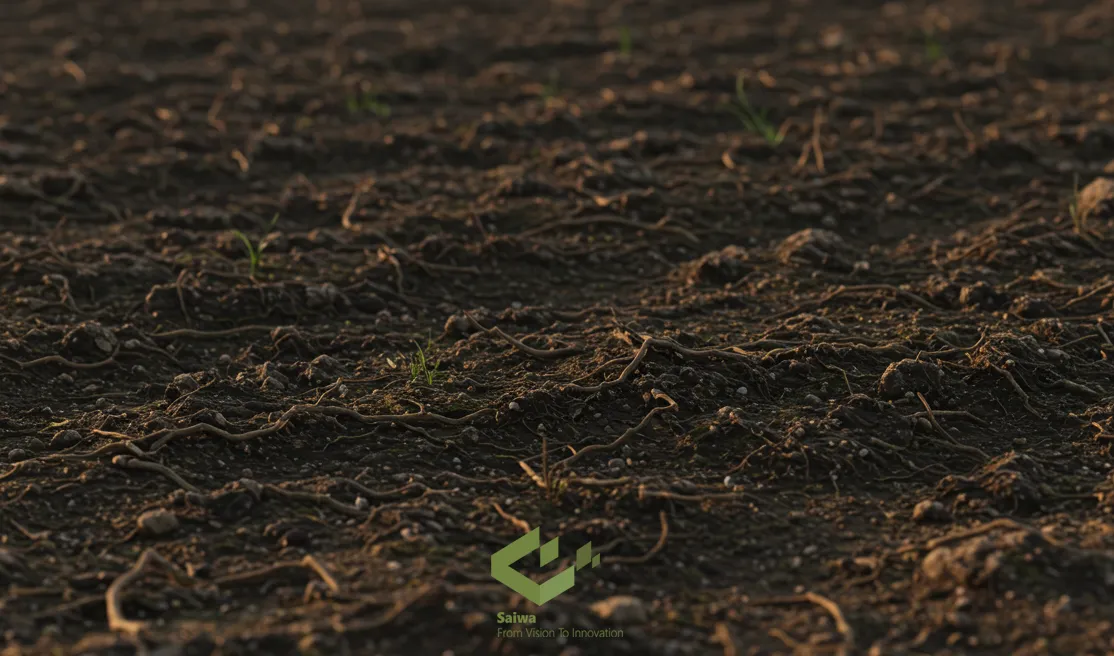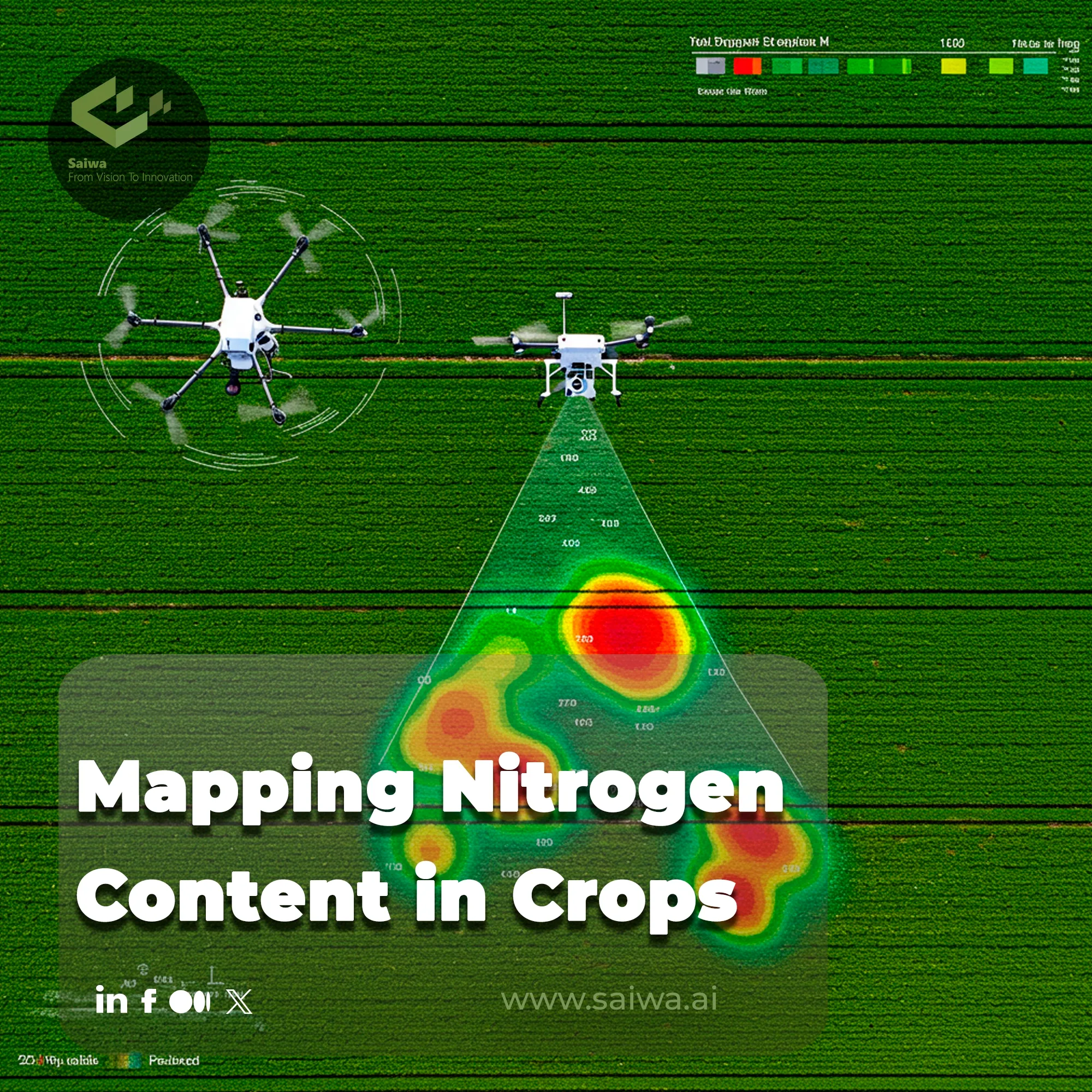Nitrogen management represents one of modern agriculture's most critical balancing acts. As the elemental building block for amino acids and chlorophyll, its availability directly governs plant vitality and productivity. However, inefficient application leads to environmental degradation through nitrate leaching and greenhouse gas emissions.
Transitioning from reactive, often delayed, field sampling to predictive, data-driven oversight is therefore essential. Advanced platforms like Saiwa's Sairone are at the forefront of this shift, utilizing AI to interpret complex aerial data. This article explores the science and practical application of mapping nitrogen distribution.
Understanding Nitrogen’s Role in Plant Growth
Nitrogen is unequivocally the most demanded nutrient for plant life, constituting 5% of a plant’s dry matter. Nitrogen in plants is fundamental to the synthesis of proteins, which regulate all metabolic processes, and forms the core of the chlorophyll molecule, the engine of photosynthesis.
An insufficient supply manifests as chlorosis—a visible yellowing, typically beginning in older leaves—and stunted growth, directly compromising the plant’s ability to thrive and produce.
Read Also : VRA Prescription Maps | Soil and Nutrient Map Insights

Traditional Nitrogen Assessment Methods
For decades, growers have relied on methods that, while informative, were often slow and provided a limited snapshot of field conditions. Key techniques included:
Soil sampling and lab analysis: This involves collecting soil cores from various field locations and sending them to a laboratory. While accurate, the process can be slow, with results taking weeks to return, delaying critical fertilizer application decisions.
Tissue sampling and nutrient index: A more immediate method involves testing the nitrate-nitrogen content in plant tissue, often using a portable nitrate meter on petiole sap. Results are compared against a sufficiency index for the plant’s specific growth stage to determine if levels are deficient, adequate, or excessive.
The Modern Approach: Mapping Nitrogen via Drone and AI
The modern alternative bypasses physical sampling for advanced remote sensing. Drones equipped with multispectral sensors perform the task of Mapping Nitrogen Content in Crops by measuring the light reflected from plant canopies.
The core insight lies in analyzing the "red edge"—a specific region in the light spectrum where reflectance sharply increases. Nitrogen deficiency in plants alters the cellular structure and chlorophyll content of leaves, causing a measurable shift in this red edge. AI models are trained to translate these subtle spectral shifts into precise nitrogen level estimates.
Interpreting a Nitrogen Distribution Map
The final output is far more than a simple image; it is a powerful data visualization tool. A nitrogen distribution map uses a color-coded gradient (e.g., red for deficient, yellow for moderate, green for sufficient) to show nitrogen variability across an entire field. This enables growers to move beyond uniform fertilizer application and adopt a precision approach, targeting inputs only where needed and in the correct amounts.
Benefits of AI-Based Nitrogen Mapping for Farmers
Adopting this data-driven strategy through plant health monitoring unlocks significant operational and financial advantages that transform farm management. Notable benefits include:
Reduced fertilizer costs and environmental runoff: Applying nutrients only where they are needed eliminates waste.
Increased crop yield and plant health: Correcting nutrient deficiencies leads to healthier, more productive crops.
Field-wide insights for optimized management: The complete spatial view enables superior Crop yield estimation and decision-making.
Support for precision agriculture programs: The data provides a foundational layer for Variable Rate Application (VRA) systems.
How the Mapping Process Works
The process, powered by platforms like Saiwa’s Sairone, streamlines data collection and analysis into a clear workflow that delivers actionable intelligence from the sky to the soil. Here is a simplified breakdown of the core steps involved in Mapping Nitrogen Content in Crops:
Step 1: Drone data acquisition over the field: A drone flies a pre-programmed route, capturing high-resolution multispectral imagery.
Step 2: Image preprocessing and segmentation: The raw images are stitched together and corrected for atmospheric distortions.
Step 3: AI analysis of leaf nitrogen indicators: An AI algorithm analyzes the spectral signature of the vegetation, pixel by pixel.

Step 4: Generation of map with nitrogen distribution: The analysis is converted into a final, intuitive, color-coded map for farmer use.
AI-Powered Nitrogen Insights with Sairone
This is where science meets practical farming. Sairone, Saiwa’s advanced agricultural platform, uses AI to automatically analyze multispectral drone imagery and translate complex spectral data into actionable nitrogen distribution maps. Sairone goes beyond simple observation, enabling the precise identification of nutrient-deficient areas and supporting the application of fertilizer in targeted areas.
For farmers, this approach replaces guesswork with data-driven certainty. Integrating Sairone into your workflow transforms aerial data into clear, field-level recommendations, reducing input waste, improving crop health, and maximizing yield. This offers a practical path toward smarter, more sustainable nitrogen management.
Conclusion
Efficient nitrogen management is no longer a guessing game; it is a science-driven process that empowers farmers to act with precision and confidence. By combining drone-based imagery with AI-powered analysis, growers can visualize nutrient variability across entire fields in real time. This allows them to replace blanket fertilizer applications with targeted, data-informed decisions. This approach maximizes crop health and yield potential while reducing input waste and minimizing environmental impact. Embracing AI-driven nitrogen mapping enables farmers to transition from reactive to proactive management strategies, fostering a more productive and sustainable future for agriculture.
Note: Some visuals on this blog post were generated using AI tools.

